Event Innovation: Happy Hours Summer Camp Development and Persuasion
VerifiedAdded on 2021/04/17
|11
|2836
|494
Essay
AI Summary
This essay presents the business idea of 'Happy Hours' summer camp, designed for elderly Australians, as an innovative concept within the event industry. It details the development of the business idea, emphasizing the use of innovation and creativity theories to establish its uniqueness. The essay explores how theories like diffusion innovation and disruptive innovation can be applied to this new venture. Furthermore, it discusses the importance of persuasion and how different theories of persuasion, such as social judgment theory and the elaboration likelihood model, can be used to attract and engage key stakeholders, including funders, customers, and suppliers. The essay concludes by highlighting the crucial role of creativity and persuasion in the successful implementation of this business idea, which aims to provide a unique and enjoyable experience for the elderly population.
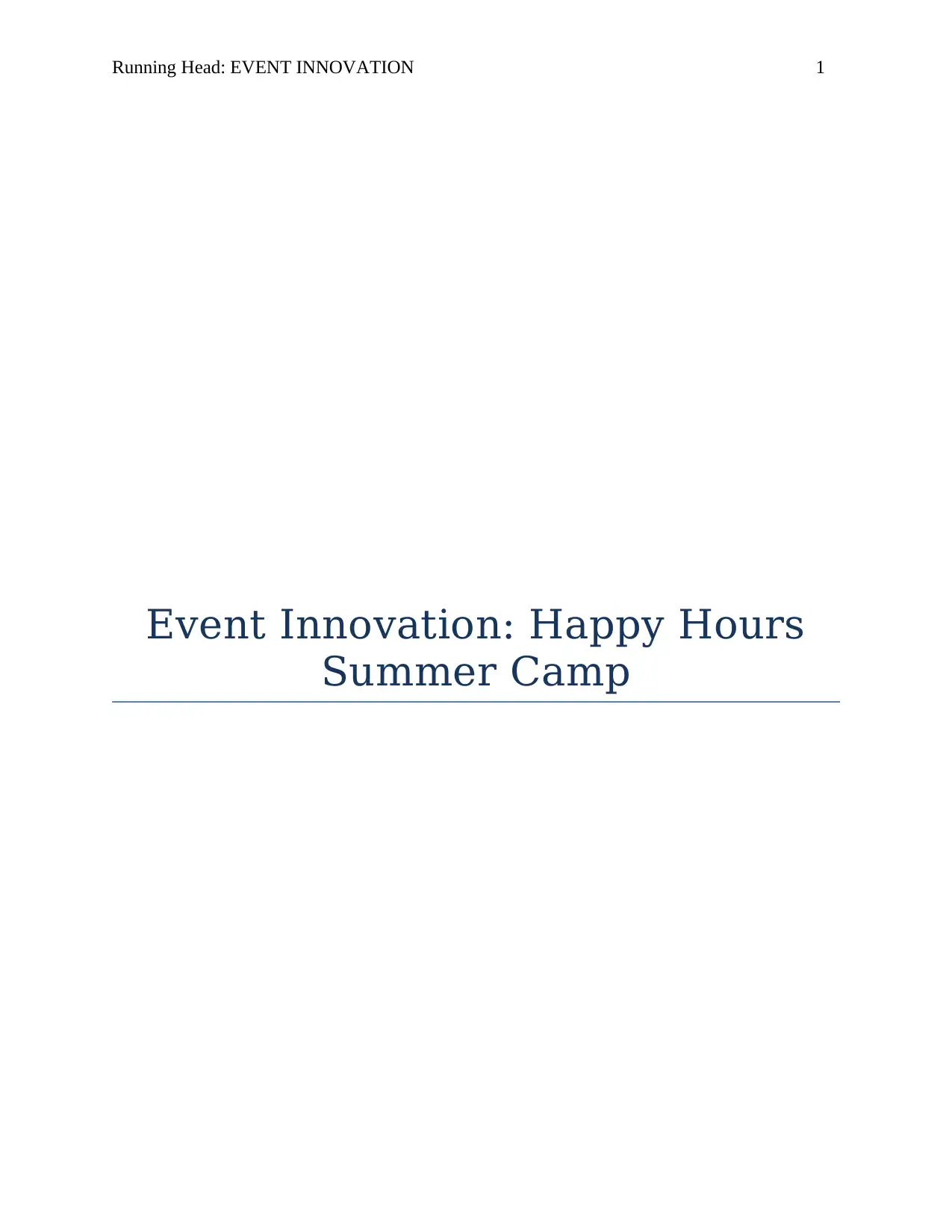
Running Head: EVENT INNOVATION 1
Event Innovation: Happy Hours
Summer Camp
Event Innovation: Happy Hours
Summer Camp
Paraphrase This Document
Need a fresh take? Get an instant paraphrase of this document with our AI Paraphraser
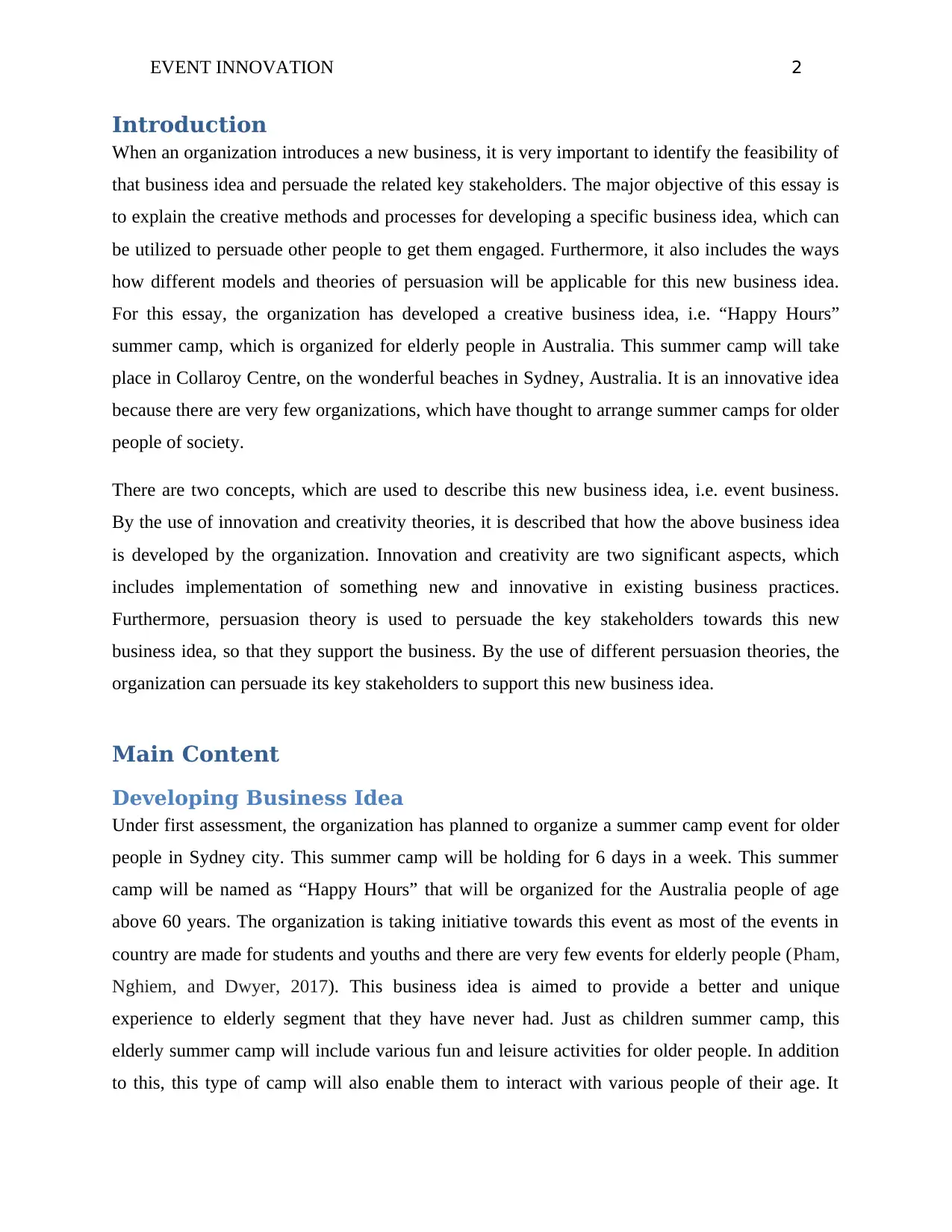
EVENT INNOVATION 2
Introduction
When an organization introduces a new business, it is very important to identify the feasibility of
that business idea and persuade the related key stakeholders. The major objective of this essay is
to explain the creative methods and processes for developing a specific business idea, which can
be utilized to persuade other people to get them engaged. Furthermore, it also includes the ways
how different models and theories of persuasion will be applicable for this new business idea.
For this essay, the organization has developed a creative business idea, i.e. “Happy Hours”
summer camp, which is organized for elderly people in Australia. This summer camp will take
place in Collaroy Centre, on the wonderful beaches in Sydney, Australia. It is an innovative idea
because there are very few organizations, which have thought to arrange summer camps for older
people of society.
There are two concepts, which are used to describe this new business idea, i.e. event business.
By the use of innovation and creativity theories, it is described that how the above business idea
is developed by the organization. Innovation and creativity are two significant aspects, which
includes implementation of something new and innovative in existing business practices.
Furthermore, persuasion theory is used to persuade the key stakeholders towards this new
business idea, so that they support the business. By the use of different persuasion theories, the
organization can persuade its key stakeholders to support this new business idea.
Main Content
Developing Business Idea
Under first assessment, the organization has planned to organize a summer camp event for older
people in Sydney city. This summer camp will be holding for 6 days in a week. This summer
camp will be named as “Happy Hours” that will be organized for the Australia people of age
above 60 years. The organization is taking initiative towards this event as most of the events in
country are made for students and youths and there are very few events for elderly people (Pham,
Nghiem, and Dwyer, 2017). This business idea is aimed to provide a better and unique
experience to elderly segment that they have never had. Just as children summer camp, this
elderly summer camp will include various fun and leisure activities for older people. In addition
to this, this type of camp will also enable them to interact with various people of their age. It
Introduction
When an organization introduces a new business, it is very important to identify the feasibility of
that business idea and persuade the related key stakeholders. The major objective of this essay is
to explain the creative methods and processes for developing a specific business idea, which can
be utilized to persuade other people to get them engaged. Furthermore, it also includes the ways
how different models and theories of persuasion will be applicable for this new business idea.
For this essay, the organization has developed a creative business idea, i.e. “Happy Hours”
summer camp, which is organized for elderly people in Australia. This summer camp will take
place in Collaroy Centre, on the wonderful beaches in Sydney, Australia. It is an innovative idea
because there are very few organizations, which have thought to arrange summer camps for older
people of society.
There are two concepts, which are used to describe this new business idea, i.e. event business.
By the use of innovation and creativity theories, it is described that how the above business idea
is developed by the organization. Innovation and creativity are two significant aspects, which
includes implementation of something new and innovative in existing business practices.
Furthermore, persuasion theory is used to persuade the key stakeholders towards this new
business idea, so that they support the business. By the use of different persuasion theories, the
organization can persuade its key stakeholders to support this new business idea.
Main Content
Developing Business Idea
Under first assessment, the organization has planned to organize a summer camp event for older
people in Sydney city. This summer camp will be holding for 6 days in a week. This summer
camp will be named as “Happy Hours” that will be organized for the Australia people of age
above 60 years. The organization is taking initiative towards this event as most of the events in
country are made for students and youths and there are very few events for elderly people (Pham,
Nghiem, and Dwyer, 2017). This business idea is aimed to provide a better and unique
experience to elderly segment that they have never had. Just as children summer camp, this
elderly summer camp will include various fun and leisure activities for older people. In addition
to this, this type of camp will also enable them to interact with various people of their age. It
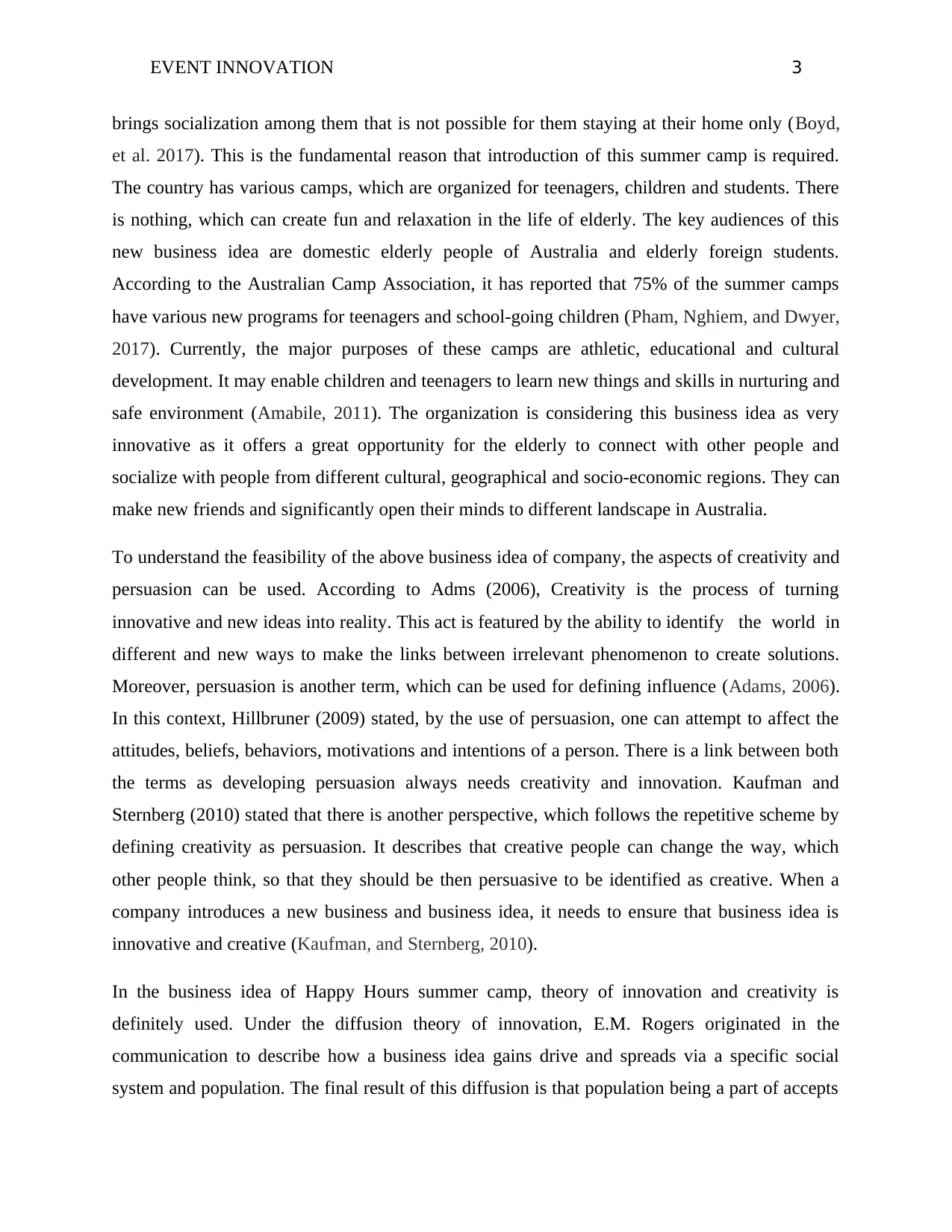
EVENT INNOVATION 3
brings socialization among them that is not possible for them staying at their home only (Boyd,
et al. 2017). This is the fundamental reason that introduction of this summer camp is required.
The country has various camps, which are organized for teenagers, children and students. There
is nothing, which can create fun and relaxation in the life of elderly. The key audiences of this
new business idea are domestic elderly people of Australia and elderly foreign students.
According to the Australian Camp Association, it has reported that 75% of the summer camps
have various new programs for teenagers and school-going children (Pham, Nghiem, and Dwyer,
2017). Currently, the major purposes of these camps are athletic, educational and cultural
development. It may enable children and teenagers to learn new things and skills in nurturing and
safe environment (Amabile, 2011). The organization is considering this business idea as very
innovative as it offers a great opportunity for the elderly to connect with other people and
socialize with people from different cultural, geographical and socio-economic regions. They can
make new friends and significantly open their minds to different landscape in Australia.
To understand the feasibility of the above business idea of company, the aspects of creativity and
persuasion can be used. According to Adms (2006), Creativity is the process of turning
innovative and new ideas into reality. This act is featured by the ability to identify the world in
different and new ways to make the links between irrelevant phenomenon to create solutions.
Moreover, persuasion is another term, which can be used for defining influence (Adams, 2006).
In this context, Hillbruner (2009) stated, by the use of persuasion, one can attempt to affect the
attitudes, beliefs, behaviors, motivations and intentions of a person. There is a link between both
the terms as developing persuasion always needs creativity and innovation. Kaufman and
Sternberg (2010) stated that there is another perspective, which follows the repetitive scheme by
defining creativity as persuasion. It describes that creative people can change the way, which
other people think, so that they should be then persuasive to be identified as creative. When a
company introduces a new business and business idea, it needs to ensure that business idea is
innovative and creative (Kaufman, and Sternberg, 2010).
In the business idea of Happy Hours summer camp, theory of innovation and creativity is
definitely used. Under the diffusion theory of innovation, E.M. Rogers originated in the
communication to describe how a business idea gains drive and spreads via a specific social
system and population. The final result of this diffusion is that population being a part of accepts
brings socialization among them that is not possible for them staying at their home only (Boyd,
et al. 2017). This is the fundamental reason that introduction of this summer camp is required.
The country has various camps, which are organized for teenagers, children and students. There
is nothing, which can create fun and relaxation in the life of elderly. The key audiences of this
new business idea are domestic elderly people of Australia and elderly foreign students.
According to the Australian Camp Association, it has reported that 75% of the summer camps
have various new programs for teenagers and school-going children (Pham, Nghiem, and Dwyer,
2017). Currently, the major purposes of these camps are athletic, educational and cultural
development. It may enable children and teenagers to learn new things and skills in nurturing and
safe environment (Amabile, 2011). The organization is considering this business idea as very
innovative as it offers a great opportunity for the elderly to connect with other people and
socialize with people from different cultural, geographical and socio-economic regions. They can
make new friends and significantly open their minds to different landscape in Australia.
To understand the feasibility of the above business idea of company, the aspects of creativity and
persuasion can be used. According to Adms (2006), Creativity is the process of turning
innovative and new ideas into reality. This act is featured by the ability to identify the world in
different and new ways to make the links between irrelevant phenomenon to create solutions.
Moreover, persuasion is another term, which can be used for defining influence (Adams, 2006).
In this context, Hillbruner (2009) stated, by the use of persuasion, one can attempt to affect the
attitudes, beliefs, behaviors, motivations and intentions of a person. There is a link between both
the terms as developing persuasion always needs creativity and innovation. Kaufman and
Sternberg (2010) stated that there is another perspective, which follows the repetitive scheme by
defining creativity as persuasion. It describes that creative people can change the way, which
other people think, so that they should be then persuasive to be identified as creative. When a
company introduces a new business and business idea, it needs to ensure that business idea is
innovative and creative (Kaufman, and Sternberg, 2010).
In the business idea of Happy Hours summer camp, theory of innovation and creativity is
definitely used. Under the diffusion theory of innovation, E.M. Rogers originated in the
communication to describe how a business idea gains drive and spreads via a specific social
system and population. The final result of this diffusion is that population being a part of accepts
⊘ This is a preview!⊘
Do you want full access?
Subscribe today to unlock all pages.

Trusted by 1+ million students worldwide
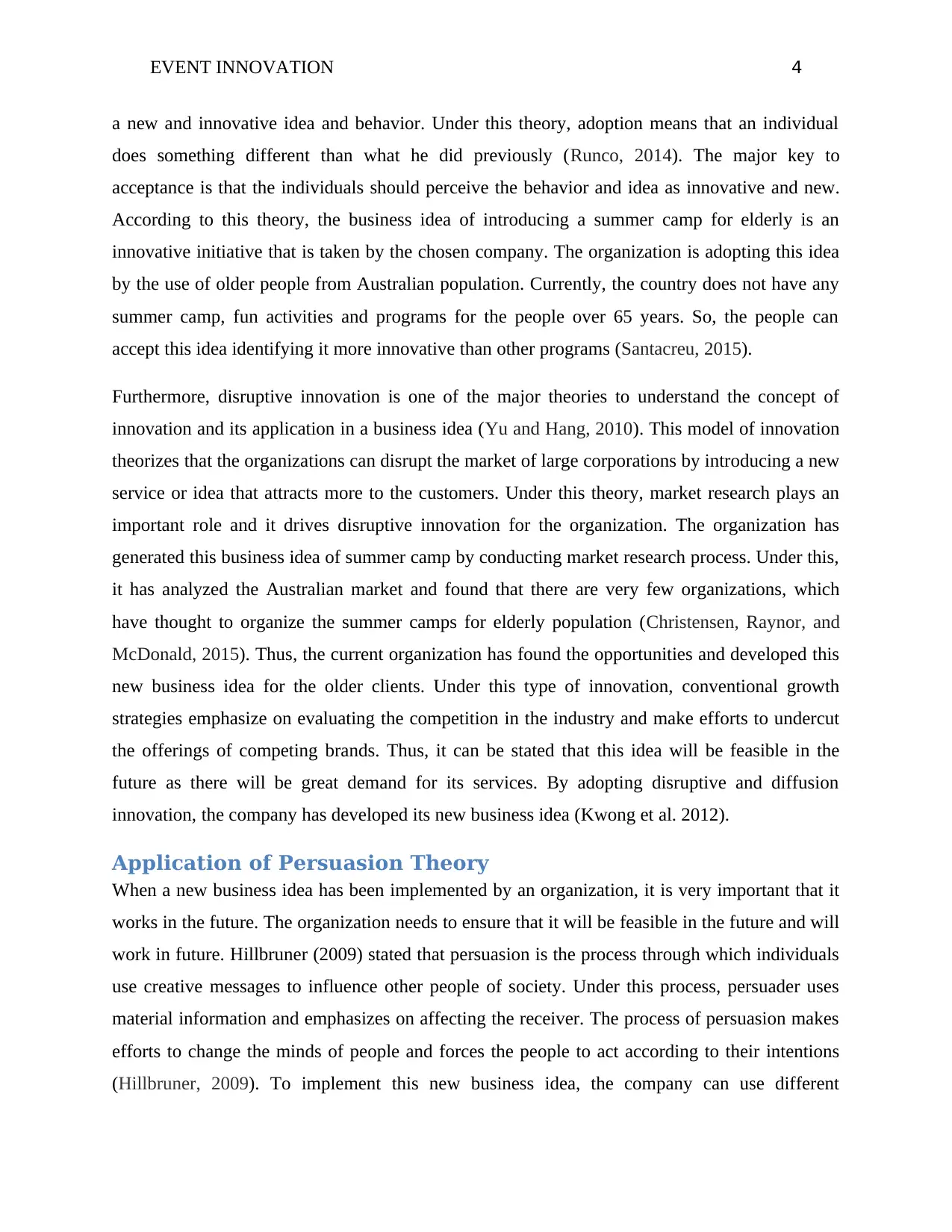
EVENT INNOVATION 4
a new and innovative idea and behavior. Under this theory, adoption means that an individual
does something different than what he did previously (Runco, 2014). The major key to
acceptance is that the individuals should perceive the behavior and idea as innovative and new.
According to this theory, the business idea of introducing a summer camp for elderly is an
innovative initiative that is taken by the chosen company. The organization is adopting this idea
by the use of older people from Australian population. Currently, the country does not have any
summer camp, fun activities and programs for the people over 65 years. So, the people can
accept this idea identifying it more innovative than other programs (Santacreu, 2015).
Furthermore, disruptive innovation is one of the major theories to understand the concept of
innovation and its application in a business idea (Yu and Hang, 2010). This model of innovation
theorizes that the organizations can disrupt the market of large corporations by introducing a new
service or idea that attracts more to the customers. Under this theory, market research plays an
important role and it drives disruptive innovation for the organization. The organization has
generated this business idea of summer camp by conducting market research process. Under this,
it has analyzed the Australian market and found that there are very few organizations, which
have thought to organize the summer camps for elderly population (Christensen, Raynor, and
McDonald, 2015). Thus, the current organization has found the opportunities and developed this
new business idea for the older clients. Under this type of innovation, conventional growth
strategies emphasize on evaluating the competition in the industry and make efforts to undercut
the offerings of competing brands. Thus, it can be stated that this idea will be feasible in the
future as there will be great demand for its services. By adopting disruptive and diffusion
innovation, the company has developed its new business idea (Kwong et al. 2012).
Application of Persuasion Theory
When a new business idea has been implemented by an organization, it is very important that it
works in the future. The organization needs to ensure that it will be feasible in the future and will
work in future. Hillbruner (2009) stated that persuasion is the process through which individuals
use creative messages to influence other people of society. Under this process, persuader uses
material information and emphasizes on affecting the receiver. The process of persuasion makes
efforts to change the minds of people and forces the people to act according to their intentions
(Hillbruner, 2009). To implement this new business idea, the company can use different
a new and innovative idea and behavior. Under this theory, adoption means that an individual
does something different than what he did previously (Runco, 2014). The major key to
acceptance is that the individuals should perceive the behavior and idea as innovative and new.
According to this theory, the business idea of introducing a summer camp for elderly is an
innovative initiative that is taken by the chosen company. The organization is adopting this idea
by the use of older people from Australian population. Currently, the country does not have any
summer camp, fun activities and programs for the people over 65 years. So, the people can
accept this idea identifying it more innovative than other programs (Santacreu, 2015).
Furthermore, disruptive innovation is one of the major theories to understand the concept of
innovation and its application in a business idea (Yu and Hang, 2010). This model of innovation
theorizes that the organizations can disrupt the market of large corporations by introducing a new
service or idea that attracts more to the customers. Under this theory, market research plays an
important role and it drives disruptive innovation for the organization. The organization has
generated this business idea of summer camp by conducting market research process. Under this,
it has analyzed the Australian market and found that there are very few organizations, which
have thought to organize the summer camps for elderly population (Christensen, Raynor, and
McDonald, 2015). Thus, the current organization has found the opportunities and developed this
new business idea for the older clients. Under this type of innovation, conventional growth
strategies emphasize on evaluating the competition in the industry and make efforts to undercut
the offerings of competing brands. Thus, it can be stated that this idea will be feasible in the
future as there will be great demand for its services. By adopting disruptive and diffusion
innovation, the company has developed its new business idea (Kwong et al. 2012).
Application of Persuasion Theory
When a new business idea has been implemented by an organization, it is very important that it
works in the future. The organization needs to ensure that it will be feasible in the future and will
work in future. Hillbruner (2009) stated that persuasion is the process through which individuals
use creative messages to influence other people of society. Under this process, persuader uses
material information and emphasizes on affecting the receiver. The process of persuasion makes
efforts to change the minds of people and forces the people to act according to their intentions
(Hillbruner, 2009). To implement this new business idea, the company can use different
Paraphrase This Document
Need a fresh take? Get an instant paraphrase of this document with our AI Paraphraser
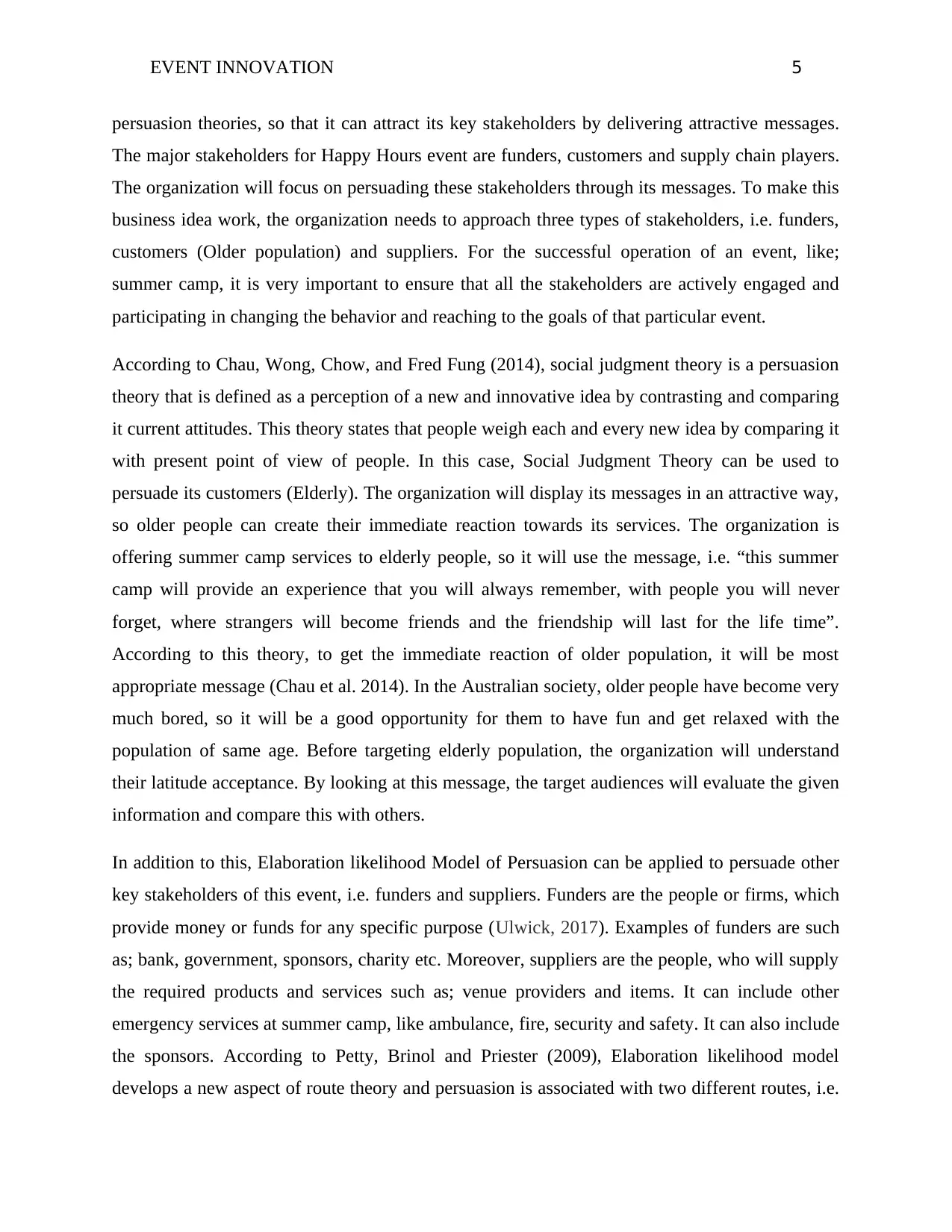
EVENT INNOVATION 5
persuasion theories, so that it can attract its key stakeholders by delivering attractive messages.
The major stakeholders for Happy Hours event are funders, customers and supply chain players.
The organization will focus on persuading these stakeholders through its messages. To make this
business idea work, the organization needs to approach three types of stakeholders, i.e. funders,
customers (Older population) and suppliers. For the successful operation of an event, like;
summer camp, it is very important to ensure that all the stakeholders are actively engaged and
participating in changing the behavior and reaching to the goals of that particular event.
According to Chau, Wong, Chow, and Fred Fung (2014), social judgment theory is a persuasion
theory that is defined as a perception of a new and innovative idea by contrasting and comparing
it current attitudes. This theory states that people weigh each and every new idea by comparing it
with present point of view of people. In this case, Social Judgment Theory can be used to
persuade its customers (Elderly). The organization will display its messages in an attractive way,
so older people can create their immediate reaction towards its services. The organization is
offering summer camp services to elderly people, so it will use the message, i.e. “this summer
camp will provide an experience that you will always remember, with people you will never
forget, where strangers will become friends and the friendship will last for the life time”.
According to this theory, to get the immediate reaction of older population, it will be most
appropriate message (Chau et al. 2014). In the Australian society, older people have become very
much bored, so it will be a good opportunity for them to have fun and get relaxed with the
population of same age. Before targeting elderly population, the organization will understand
their latitude acceptance. By looking at this message, the target audiences will evaluate the given
information and compare this with others.
In addition to this, Elaboration likelihood Model of Persuasion can be applied to persuade other
key stakeholders of this event, i.e. funders and suppliers. Funders are the people or firms, which
provide money or funds for any specific purpose (Ulwick, 2017). Examples of funders are such
as; bank, government, sponsors, charity etc. Moreover, suppliers are the people, who will supply
the required products and services such as; venue providers and items. It can include other
emergency services at summer camp, like ambulance, fire, security and safety. It can also include
the sponsors. According to Petty, Brinol and Priester (2009), Elaboration likelihood model
develops a new aspect of route theory and persuasion is associated with two different routes, i.e.
persuasion theories, so that it can attract its key stakeholders by delivering attractive messages.
The major stakeholders for Happy Hours event are funders, customers and supply chain players.
The organization will focus on persuading these stakeholders through its messages. To make this
business idea work, the organization needs to approach three types of stakeholders, i.e. funders,
customers (Older population) and suppliers. For the successful operation of an event, like;
summer camp, it is very important to ensure that all the stakeholders are actively engaged and
participating in changing the behavior and reaching to the goals of that particular event.
According to Chau, Wong, Chow, and Fred Fung (2014), social judgment theory is a persuasion
theory that is defined as a perception of a new and innovative idea by contrasting and comparing
it current attitudes. This theory states that people weigh each and every new idea by comparing it
with present point of view of people. In this case, Social Judgment Theory can be used to
persuade its customers (Elderly). The organization will display its messages in an attractive way,
so older people can create their immediate reaction towards its services. The organization is
offering summer camp services to elderly people, so it will use the message, i.e. “this summer
camp will provide an experience that you will always remember, with people you will never
forget, where strangers will become friends and the friendship will last for the life time”.
According to this theory, to get the immediate reaction of older population, it will be most
appropriate message (Chau et al. 2014). In the Australian society, older people have become very
much bored, so it will be a good opportunity for them to have fun and get relaxed with the
population of same age. Before targeting elderly population, the organization will understand
their latitude acceptance. By looking at this message, the target audiences will evaluate the given
information and compare this with others.
In addition to this, Elaboration likelihood Model of Persuasion can be applied to persuade other
key stakeholders of this event, i.e. funders and suppliers. Funders are the people or firms, which
provide money or funds for any specific purpose (Ulwick, 2017). Examples of funders are such
as; bank, government, sponsors, charity etc. Moreover, suppliers are the people, who will supply
the required products and services such as; venue providers and items. It can include other
emergency services at summer camp, like ambulance, fire, security and safety. It can also include
the sponsors. According to Petty, Brinol and Priester (2009), Elaboration likelihood model
develops a new aspect of route theory and persuasion is associated with two different routes, i.e.
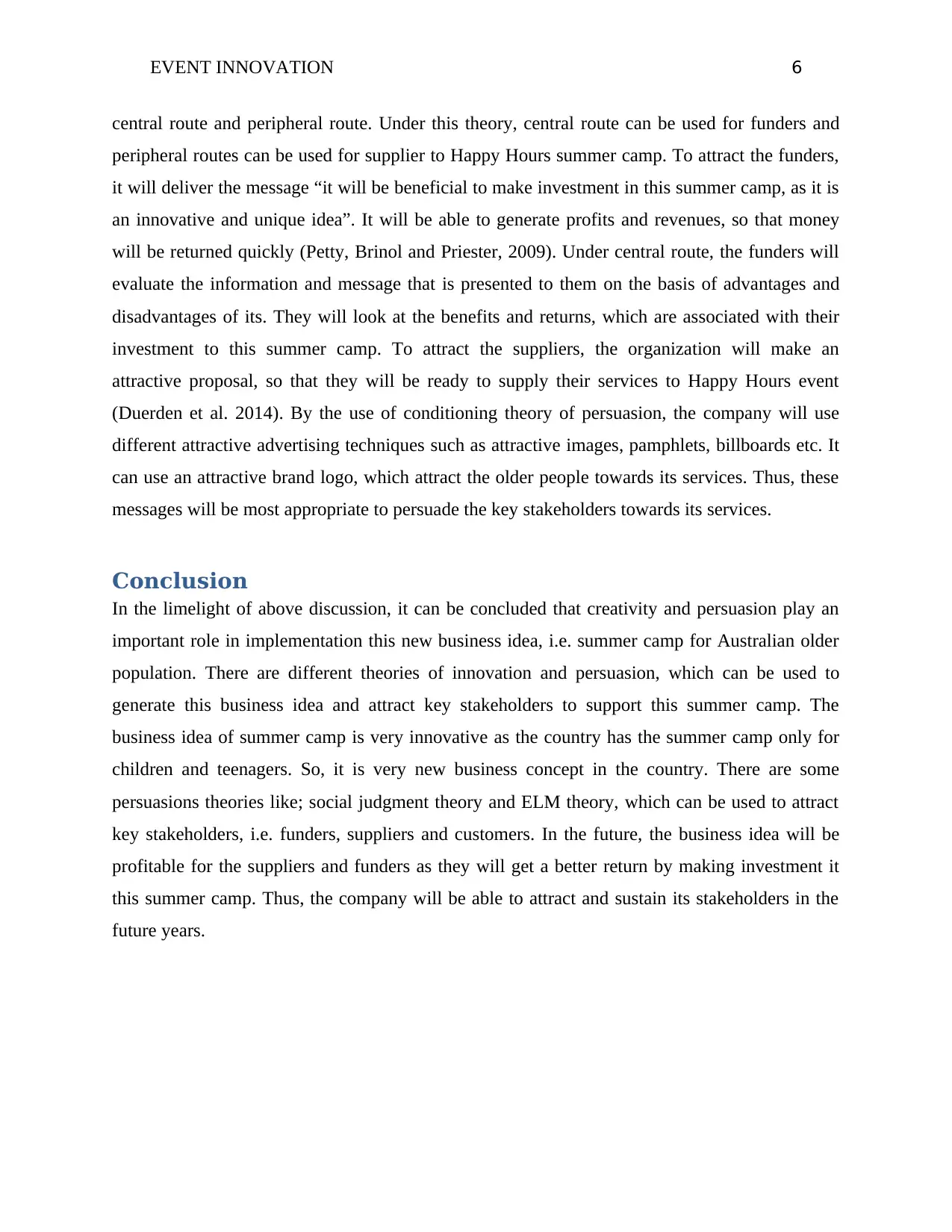
EVENT INNOVATION 6
central route and peripheral route. Under this theory, central route can be used for funders and
peripheral routes can be used for supplier to Happy Hours summer camp. To attract the funders,
it will deliver the message “it will be beneficial to make investment in this summer camp, as it is
an innovative and unique idea”. It will be able to generate profits and revenues, so that money
will be returned quickly (Petty, Brinol and Priester, 2009). Under central route, the funders will
evaluate the information and message that is presented to them on the basis of advantages and
disadvantages of its. They will look at the benefits and returns, which are associated with their
investment to this summer camp. To attract the suppliers, the organization will make an
attractive proposal, so that they will be ready to supply their services to Happy Hours event
(Duerden et al. 2014). By the use of conditioning theory of persuasion, the company will use
different attractive advertising techniques such as attractive images, pamphlets, billboards etc. It
can use an attractive brand logo, which attract the older people towards its services. Thus, these
messages will be most appropriate to persuade the key stakeholders towards its services.
Conclusion
In the limelight of above discussion, it can be concluded that creativity and persuasion play an
important role in implementation this new business idea, i.e. summer camp for Australian older
population. There are different theories of innovation and persuasion, which can be used to
generate this business idea and attract key stakeholders to support this summer camp. The
business idea of summer camp is very innovative as the country has the summer camp only for
children and teenagers. So, it is very new business concept in the country. There are some
persuasions theories like; social judgment theory and ELM theory, which can be used to attract
key stakeholders, i.e. funders, suppliers and customers. In the future, the business idea will be
profitable for the suppliers and funders as they will get a better return by making investment it
this summer camp. Thus, the company will be able to attract and sustain its stakeholders in the
future years.
central route and peripheral route. Under this theory, central route can be used for funders and
peripheral routes can be used for supplier to Happy Hours summer camp. To attract the funders,
it will deliver the message “it will be beneficial to make investment in this summer camp, as it is
an innovative and unique idea”. It will be able to generate profits and revenues, so that money
will be returned quickly (Petty, Brinol and Priester, 2009). Under central route, the funders will
evaluate the information and message that is presented to them on the basis of advantages and
disadvantages of its. They will look at the benefits and returns, which are associated with their
investment to this summer camp. To attract the suppliers, the organization will make an
attractive proposal, so that they will be ready to supply their services to Happy Hours event
(Duerden et al. 2014). By the use of conditioning theory of persuasion, the company will use
different attractive advertising techniques such as attractive images, pamphlets, billboards etc. It
can use an attractive brand logo, which attract the older people towards its services. Thus, these
messages will be most appropriate to persuade the key stakeholders towards its services.
Conclusion
In the limelight of above discussion, it can be concluded that creativity and persuasion play an
important role in implementation this new business idea, i.e. summer camp for Australian older
population. There are different theories of innovation and persuasion, which can be used to
generate this business idea and attract key stakeholders to support this summer camp. The
business idea of summer camp is very innovative as the country has the summer camp only for
children and teenagers. So, it is very new business concept in the country. There are some
persuasions theories like; social judgment theory and ELM theory, which can be used to attract
key stakeholders, i.e. funders, suppliers and customers. In the future, the business idea will be
profitable for the suppliers and funders as they will get a better return by making investment it
this summer camp. Thus, the company will be able to attract and sustain its stakeholders in the
future years.
⊘ This is a preview!⊘
Do you want full access?
Subscribe today to unlock all pages.

Trusted by 1+ million students worldwide
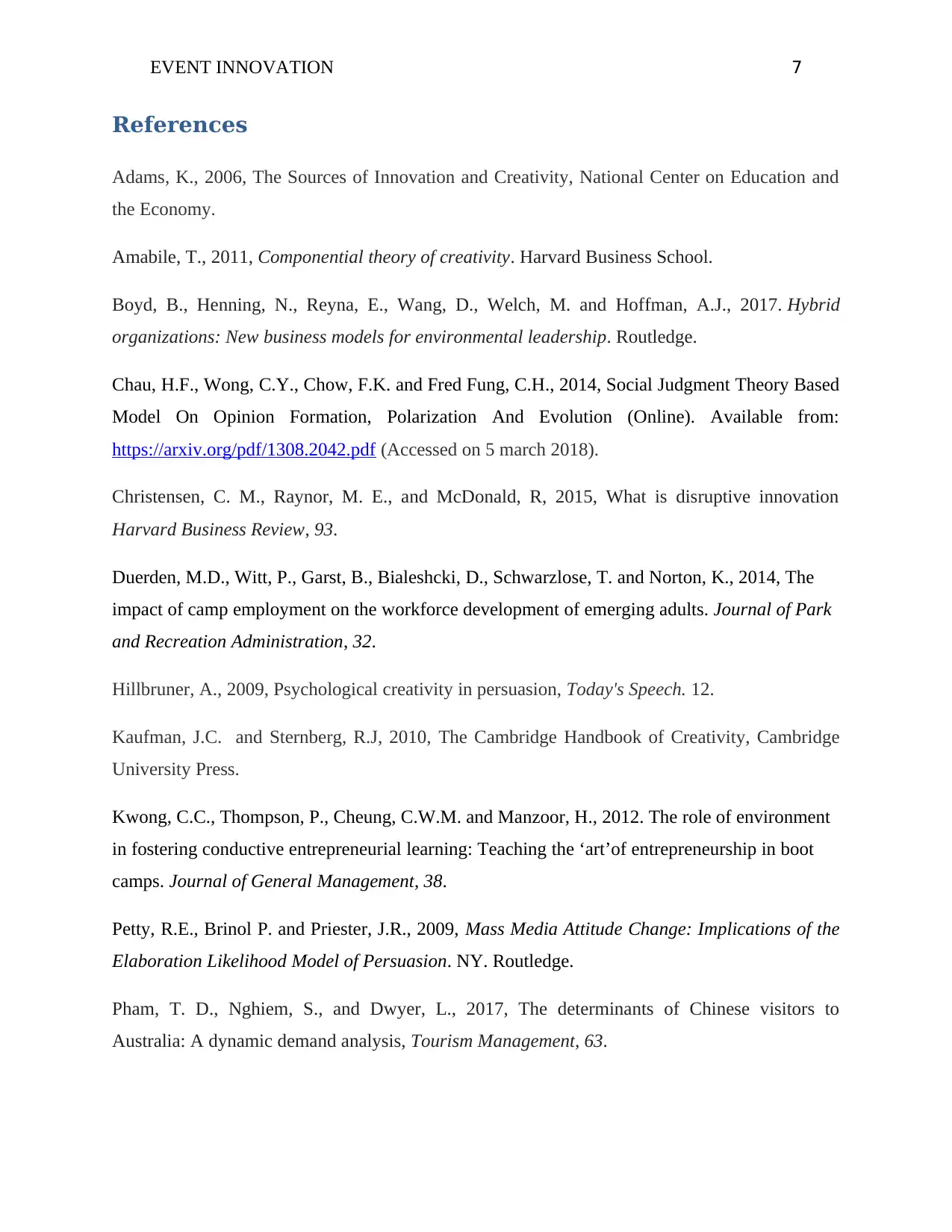
EVENT INNOVATION 7
References
Adams, K., 2006, The Sources of Innovation and Creativity, National Center on Education and
the Economy.
Amabile, T., 2011, Componential theory of creativity. Harvard Business School.
Boyd, B., Henning, N., Reyna, E., Wang, D., Welch, M. and Hoffman, A.J., 2017. Hybrid
organizations: New business models for environmental leadership. Routledge.
Chau, H.F., Wong, C.Y., Chow, F.K. and Fred Fung, C.H., 2014, Social Judgment Theory Based
Model On Opinion Formation, Polarization And Evolution (Online). Available from:
https://arxiv.org/pdf/1308.2042.pdf (Accessed on 5 march 2018).
Christensen, C. M., Raynor, M. E., and McDonald, R, 2015, What is disruptive innovation
Harvard Business Review, 93.
Duerden, M.D., Witt, P., Garst, B., Bialeshcki, D., Schwarzlose, T. and Norton, K., 2014, The
impact of camp employment on the workforce development of emerging adults. Journal of Park
and Recreation Administration, 32.
Hillbruner, A., 2009, Psychological creativity in persuasion, Today's Speech. 12.
Kaufman, J.C. and Sternberg, R.J, 2010, The Cambridge Handbook of Creativity, Cambridge
University Press.
Kwong, C.C., Thompson, P., Cheung, C.W.M. and Manzoor, H., 2012. The role of environment
in fostering conductive entrepreneurial learning: Teaching the ‘art’of entrepreneurship in boot
camps. Journal of General Management, 38.
Petty, R.E., Brinol P. and Priester, J.R., 2009, Mass Media Attitude Change: Implications of the
Elaboration Likelihood Model of Persuasion. NY. Routledge.
Pham, T. D., Nghiem, S., and Dwyer, L., 2017, The determinants of Chinese visitors to
Australia: A dynamic demand analysis, Tourism Management, 63.
References
Adams, K., 2006, The Sources of Innovation and Creativity, National Center on Education and
the Economy.
Amabile, T., 2011, Componential theory of creativity. Harvard Business School.
Boyd, B., Henning, N., Reyna, E., Wang, D., Welch, M. and Hoffman, A.J., 2017. Hybrid
organizations: New business models for environmental leadership. Routledge.
Chau, H.F., Wong, C.Y., Chow, F.K. and Fred Fung, C.H., 2014, Social Judgment Theory Based
Model On Opinion Formation, Polarization And Evolution (Online). Available from:
https://arxiv.org/pdf/1308.2042.pdf (Accessed on 5 march 2018).
Christensen, C. M., Raynor, M. E., and McDonald, R, 2015, What is disruptive innovation
Harvard Business Review, 93.
Duerden, M.D., Witt, P., Garst, B., Bialeshcki, D., Schwarzlose, T. and Norton, K., 2014, The
impact of camp employment on the workforce development of emerging adults. Journal of Park
and Recreation Administration, 32.
Hillbruner, A., 2009, Psychological creativity in persuasion, Today's Speech. 12.
Kaufman, J.C. and Sternberg, R.J, 2010, The Cambridge Handbook of Creativity, Cambridge
University Press.
Kwong, C.C., Thompson, P., Cheung, C.W.M. and Manzoor, H., 2012. The role of environment
in fostering conductive entrepreneurial learning: Teaching the ‘art’of entrepreneurship in boot
camps. Journal of General Management, 38.
Petty, R.E., Brinol P. and Priester, J.R., 2009, Mass Media Attitude Change: Implications of the
Elaboration Likelihood Model of Persuasion. NY. Routledge.
Pham, T. D., Nghiem, S., and Dwyer, L., 2017, The determinants of Chinese visitors to
Australia: A dynamic demand analysis, Tourism Management, 63.
Paraphrase This Document
Need a fresh take? Get an instant paraphrase of this document with our AI Paraphraser
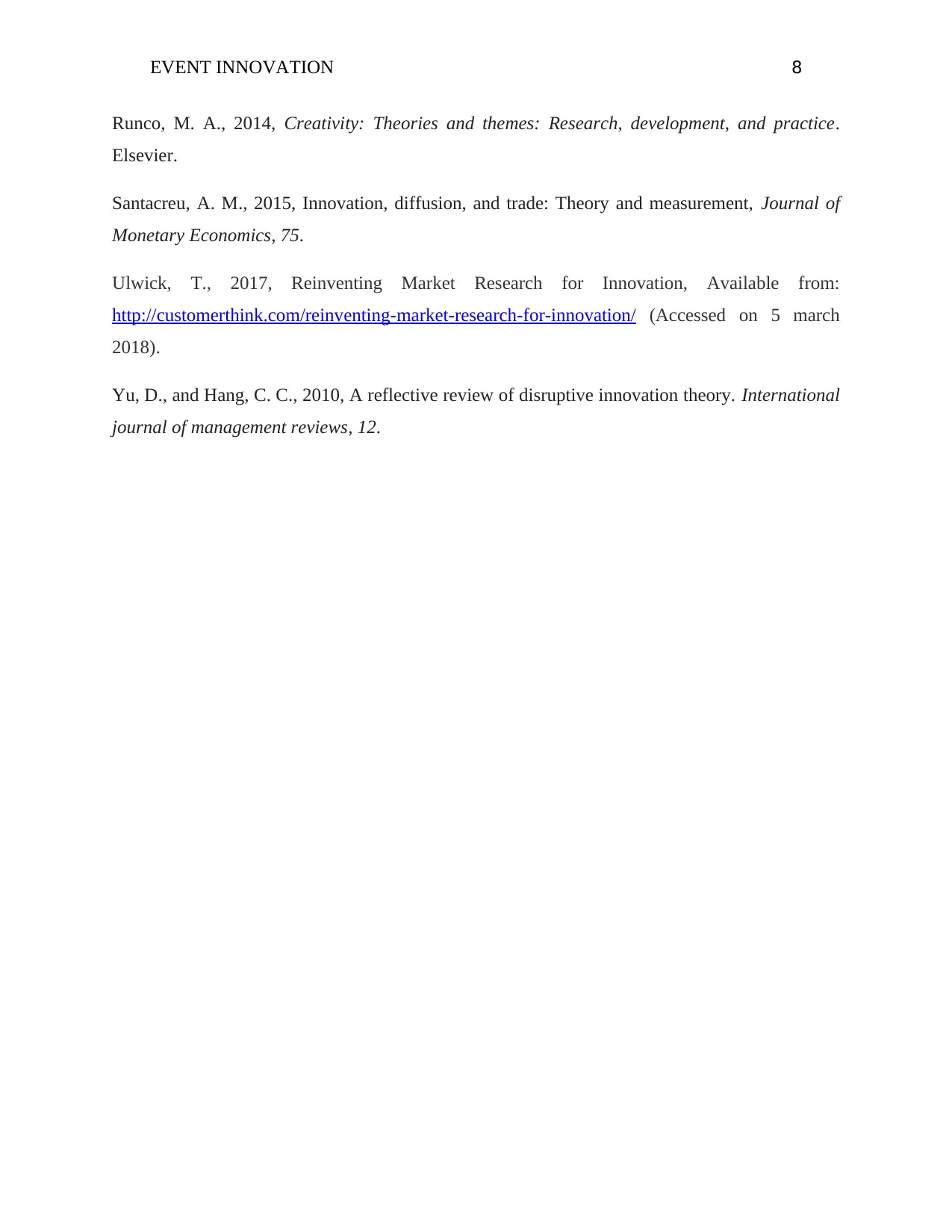
EVENT INNOVATION 8
Runco, M. A., 2014, Creativity: Theories and themes: Research, development, and practice.
Elsevier.
Santacreu, A. M., 2015, Innovation, diffusion, and trade: Theory and measurement, Journal of
Monetary Economics, 75.
Ulwick, T., 2017, Reinventing Market Research for Innovation, Available from:
http://customerthink.com/reinventing-market-research-for-innovation/ (Accessed on 5 march
2018).
Yu, D., and Hang, C. C., 2010, A reflective review of disruptive innovation theory. International
journal of management reviews, 12.
Runco, M. A., 2014, Creativity: Theories and themes: Research, development, and practice.
Elsevier.
Santacreu, A. M., 2015, Innovation, diffusion, and trade: Theory and measurement, Journal of
Monetary Economics, 75.
Ulwick, T., 2017, Reinventing Market Research for Innovation, Available from:
http://customerthink.com/reinventing-market-research-for-innovation/ (Accessed on 5 march
2018).
Yu, D., and Hang, C. C., 2010, A reflective review of disruptive innovation theory. International
journal of management reviews, 12.

EVENT INNOVATION 9
⊘ This is a preview!⊘
Do you want full access?
Subscribe today to unlock all pages.

Trusted by 1+ million students worldwide

EVENT INNOVATION 10
Paraphrase This Document
Need a fresh take? Get an instant paraphrase of this document with our AI Paraphraser

EVENT INNOVATION 11
1 out of 11
Related Documents
Your All-in-One AI-Powered Toolkit for Academic Success.
+13062052269
info@desklib.com
Available 24*7 on WhatsApp / Email
![[object Object]](/_next/static/media/star-bottom.7253800d.svg)
Unlock your academic potential
Copyright © 2020–2025 A2Z Services. All Rights Reserved. Developed and managed by ZUCOL.




